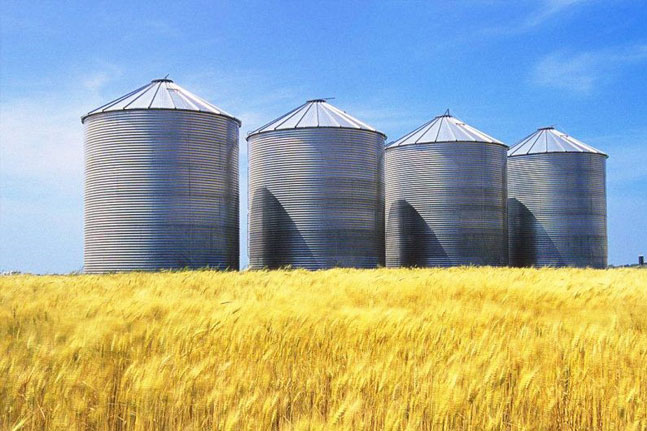
PUTTING A NUMBER ON HUNGER: DIFFERENT MEASURES FOR DIFFERENT PURPOSES
April 18, 2024
NEW AGRICULTURE TECHNOLOGY IN MODERN FARMING
June 24, 2024If storing grain for a longer period of time is part of your marketing strategy, follow these tips to keep grain in condition.
To most effectively market your grain, you may need to store it into summer and possibly into the next year. To do so, you’re going to need to store it properly. If you don’t and it goes out of condition, you may have to market corn before you’re ready, warns Gary Woodruff, GSI.
- PREPARE GRAIN BINS
The first step for quality grain is to make sure your storage facilities are prepared for the grain going in. Clean out your bins and get rid of any grain left that might have insects in it. Also, check under floor areas. “These can be a real nice spot for insects to go from one season to the next,” advises Ken Hellevang, North Dakota State University Extension engineer. “If you had an insect infestation at the end of last year, make sure you fumigate or thoroughly clean the bin.”
It may be too late to take this step for this grain storage season, but keep it in mind for the coming years.
- STORE QUALITY GRAIN
The condition of the corn as you harvest it is going to determine how well it’s going to store. “If you are thinking long-term storage, you are best to start out with mature, good-quality corn,” says Hellevang. “Some of the corn in the Northern region got frosted this year. That grain might be a little immature, be lower in test weight, and likely not be corn that would have as good a chance of making long-term storage as good-quality corn does.”
- DRY TO THE RIGHT MOISTURE CONTENT
The maximum allowable storage life chart on the next page shows how long corn at different moisture contents can be stored at different temperatures. For long-term storage, you will need to dry grain to a lower moisture level.
“We’ve gotten in the mind-set that we can put 15% in the bin and we are good to go,” says Woodruff. This is no longer the case.
“You cannot beat the physical laws of storing corn, which say 15% moisture if you store until June 1, 14% through next harvest, and 13% to store for a year or longer,” he says. At 13% moisture, mold growth is prevented, keeping grain in better condition.
For soybeans, you will need to dry down a little bit more. “13% is what is typically done for storage in cooler months,” says Hellevang. “If you are going into summer temperatures, the moisture content of soybeans should really be closer to 11%.”
- IMPROVE AERATION
Properly distributing fines with a grain spreader or by practicing repetitive coring will help improve aeration. A grain spreader can be used on bins smaller than 48 feet to spread out fines.
“It’s important to have fines spread out in the bin, so they aren’t all in the center,” says Kerry Hartwig, Sukup. “Air is just like people and water; it takes the path of least resistance. If there are a lot of fines in the center, the air will go up the outside and you will get a lot of spoilage in the center.”
For larger grain bins, load directly into the bin. Then every 10 to 15 feet, pull out about 300 bushels of grain, creating an inverted cone. This process is known as repetitive coring and will help remove fines in the center.
After harvest is over, pull the bins with peaked grain down so the center is just below the corn at the wall, advises Woodruff. The grain will look somewhat like an “M” from the side. This helps bring air movement to the center and facilitates the removal of fines and foreign material from the center of the bin.
- CONTROL THE TEMPERATURE
The ability to control the temperature of grain during storage is critical, says Hellevang. “You should be putting grain into a storage system that has a good aeration system so you can control the grain temperature,” he says.
The other important aspect of this is temperature cables. “I would recommend having temperature cables in the bin so you have a safe way to monitor the grain,” says Hartwig.
Recommendations for the exact temperature to store differ by region and season. “In the Northern regions, I recommend bringing the grain temperature down to freezing or even below for winter storage,” says Hellevang. “In Southern states, our typical target is 40°F.”
- KEEP COOL IN SUMMER
There is some disagreement on the best storage temperature for grain over the summer. The old-school recommendation was to warm the grain to within 10° to 15° of the outside temperature. For the last 20 years, the recommendation has been to keep the grain cool, about 40°F., during spring and summer. Some are now suggesting warming the grain up to 50°F. for storage over summer.
“If you are going to sell by June 1, you can leave grain cold,” says Woodruff. “If you’re going to bring it up to temperature for a later sell, I’d stop at 50°F. to 60°F.”
Hellevang recommends keeping the grain near 40°F. “Part of the reason for the lower temperature trend the last several years is that insect infestation and mold growth are going to flourish in the 70°F. to 90°F. temperature range,” he explains. “If you can keep the temperature below 50°F., the insects are dormant.”
- CHECK GRAIN FREQUENTLY
The long-recommended practice is to check your grain weekly during the summer. “The old story is if you had a 50,000-bushel bin with $200,000 in a 5-gallon bucket at the top, you would be out there three times a day checking it,” says Woodruff. “That’s how much money is in that bin, and some won’t check it once a month. You need to be checking it weekly.”
Climb to the top and, without entering, see if there is a crust or any noticeable smell. An increase in surface moisture is often the first sign of problems. If there is anything wrong, start your aeration fans. A bin with an appropriately sized aeration fan will have enough airflow to dry a small layer of moisture on top of the bin.
When you check the grain, collect a sample to determine the moisture content, says Hellevang.
“The only real fix for out-of-condition issues that aren’t stopped by aeration is to unload the bin down to where the affected grain is and remove it,” says Woodruff. “This likely means the grain will have to be marketed early, and poor-grain quality may receive a dock at the elevator. Prevention is always the best answer.”
During fall, check grain once a week. In winter, you’ll get a bit of a break – you only need to check it every few weeks.
“When you are changing the grain temperature in the fall, until you get a history of how that grain is handling in the bin, it should be checked every week,” says Hellevang. “Once you get into the cool winter months, things stabilize, and checking every couple of weeks should be adequate.”
- WATCH FOR INSECTS
Another reason to check grain frequently during the summer is to watch for insects.
“In warmer temperatures, you can go from one or two insects to a major infestation in a period of two to three weeks,” says Hellevang. “If you aren’t checking every week or so, you aren’t able to take corrective action. You will end up reacting to major problems.”
Woodruff also recommends insect traps. “If you are keeping grain into the late summer, you’re probably better off putting in insect traps to see if there are any present,” he says. “If there are, you need to treat the grain.”
For more information on grain storage and for temperature recommendations for your region, check with your local university Extension office.





